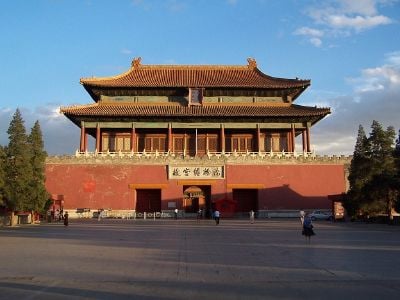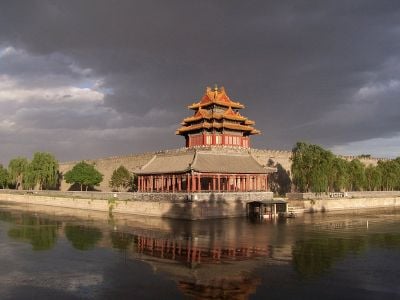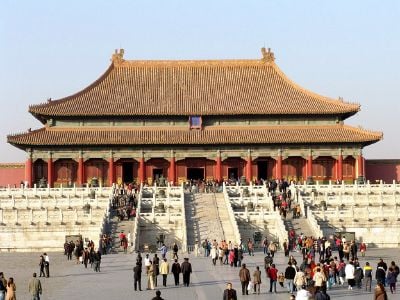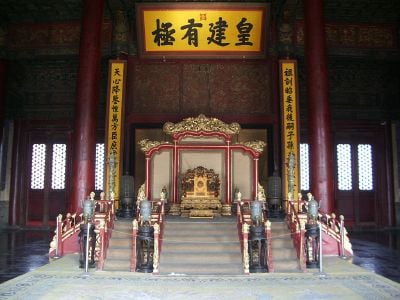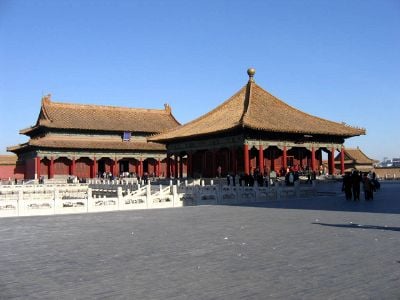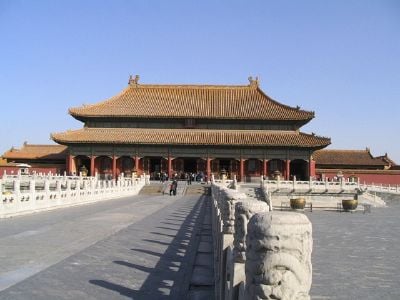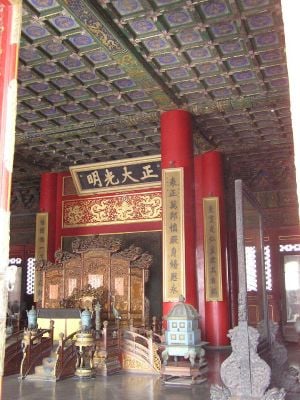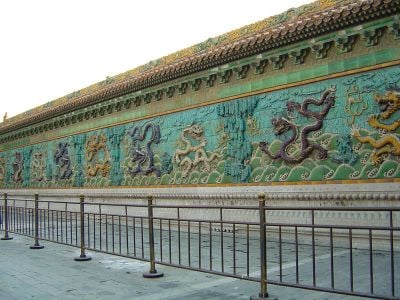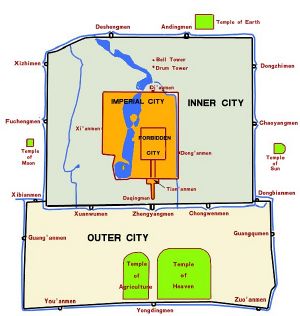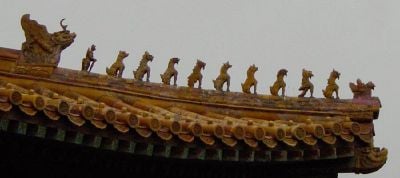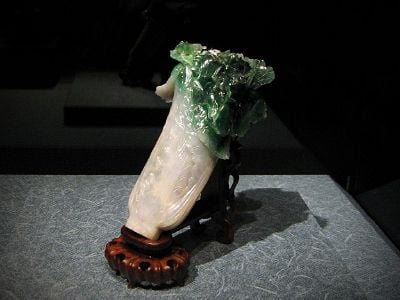Forbidden City
- "Gugong" redirects here.
| Imperial Palaces of the Ming and Qing Dynasties in Beijing and Shenyang* | |
|---|---|
| UNESCO World Heritage Site | |
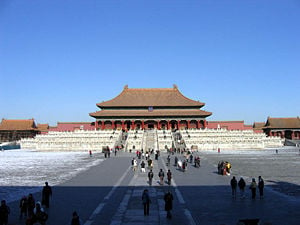
| |
| State Party | |
| Type | Cultural |
| Criteria | i, ii, iii, iv |
| Reference | 439 |
| Region** | Asia-Pacific |
| Inscription history | |
| Inscription | 1987 (11th Session) |
| Extensions | 2004 |
| * Name as inscribed on World Heritage List. ** Region as classified by UNESCO. | |
The Forbidden City was the Chinese imperial palace from the mid-Ming Dynasty (1420 - 1912) to the end of the Qing Dynasty (1644 - 1911). It is located in the middle of Beijing, China and now houses the Palace Museum. For almost five centuries, it served as the home of the Emperor and his household, and the ceremonial and political center of Chinese government. Built from 1406 to 1420, the complex consists of 980 surviving buildings with 8,707 bays of rooms and covers 720,000 square meters. The palace complex exemplifies traditional Chinese palatial architecture, and has influenced cultural and architectural developments in East Asia and elsewhere. The Forbidden City was declared a World Heritage Site in 1987, and is listed by UNESCO as the largest collection of preserved ancient wooden structures in the world.
Since 1924, the Forbidden City has been under the charge of the Palace Museum, whose extensive collection of artwork and artifacts was built upon the imperial collections of the Ming and Qing dynasties. Part of the museum's former collection is now located in the National Palace Museum in Taipei. Both museums descend from the same institution, but were split after the Chinese Civil War.
| This article contains Chinese text. Without proper rendering support, you may see question marks, boxes, or other symbols instead of Chinese characters. |
Name
The common English name, "the Forbidden City," is a translation of the Chinese name Zijin Cheng (Chinese: 紫禁城; pinyin: Zǐjinchéng; literally "Purple Forbidden City"). Another English name of similar origin is "Forbidden Palace."[1] In the Manchu language it is called Dabkūri dorgi hoton (Manchu: ![]() ), which literally means the "Layered Inner City."
), which literally means the "Layered Inner City."
The name "Zijin Cheng" is a name imbued with significance on many levels. Zi, or "Purple," refers to the North Star, which in ancient China was called the Ziwei Star, and in traditional Chinese astrology was the abode of the Celestial Emperor. The surrounding celestial region, the Ziwei Enclosure (Chinese: 紫微垣; pinyin: Zǐwēiyuán), was the realm of the Celestial Emperor and his family. The Forbidden City, as the residence of the terrestrial emperor, was its earthly counterpart. Jin, or "Forbidden," referred to the fact that no one could enter or leave the palace without the emperor's permission. Cheng means a walled city.[2]
Today, the site is most commonly known in Chinese as Gugong (故宫), which means the "Former Palace."[3] The museum which is based in these buildings is known as the "Palace Museum" (Chinese: 故宫博物院; pinyin: Gùgōng Bówùyùan).
History

The site of the Forbidden City was part of the Imperial city during the Mongol Yuan Dynasty. Upon the establishment of the Ming Dynasty, the Hongwu Emperor moved the capital from Beijing in the north to Nanjing in the south, and ordered that the Mongol palaces be razed. When his son Zhu Di became the Yongle Emperor, he moved the capital to Beijing, and in 1406 construction began on what would become the Forbidden City.[2]
Construction lasted for fifteen years, and required the labor of 100,000 artisans and more than a million workers.[4] The materials used in construction included whole logs of precious Phoebe zhennan wood (Chinese: 楠木; pinyin: nánmù) found in the jungles of south-western China, and large blocks of marble from quarries near Beijing. The grand terraces and large stone carvings were made of stone from quarries near Beijing. The larger pieces could not be transported conventionally. Instead, wells were dug along the way, and water from the wells was poured on the road in deep winter, forming a layer of ice. The stones were dragged along the ice.[5]
The floors of major halls were paved with "golden bricks" (Chinese: 金砖; pinyin: jīnzhuān), baked with clay from seven counties of Suzhou and Songjiang prefectures.[6] Each batch took months to bake, resulting in smooth bricks that ring with a metallic sound.[4] Much of the interior paving seen today is six-century-old original bricks.
From 1420 to 1644, the Forbidden City was the seat of the Ming Dynasty. In April 1644, it was captured by rebel forces led by Li Zicheng, who proclaimed himself emperor of the Shun Dynasty.[7] He soon fled before the combined armies of former Ming general Wu Sangui and Manchu forces, setting fire to parts of the Forbidden City.[8] By October, the Manchus had achieved supremacy in northern China, and a ceremony was held at the Forbidden City to proclaim the young Shunzhi Emperor as ruler of all China under the Qing Dynasty.[9]
The Qing rulers changed the names of the principal buildings, to emphasize "Harmony" rather than "Supremacy,"[10] made the name plates bilingual (Chinese and Manchu), and introduced Shamanist elements to the palace.
In 1860, during the Second Opium War, Anglo-French forces took control of the Forbidden City and occupied it until the end of the war.[11] In 1900 Empress Dowager Cixi fled from the Forbidden City during the Boxer Rebellion, leaving it to be occupied by forces of the treaty powers until the following year.
In 1912, Puyi, the last Emperor of China, abdicated. Under an agreement with the new Republic of China government, Puyi remained in the Inner Court, while the Outer Court was given over to public use,[12] In 1923 Reginald Johnston, Puyi's English teacher, told Puyi about eunuchs smuggling treasures out of the palace and selling them in antique shops. Puyi ordered an audit of the palace's collections. Before it began, a fire consumed the gardens of the Palace of Establishing Prosperity (建福宫) where the bulk of the Qianlong Emperor's collection of art works was stored. In his memoir, Puyi claimed the fire was started by the eunuchs to conceal their embezzlement. This fire further fueled public sentiments against Puyi's continued occupation of the palace.[13] The gardens were not rebuilt until 2005.[14]
In 1924, Feng Yuxiang took control of Beijing in a coup. Denouncing the previous agreement with the Qing imperial house, Feng expelled Puyi from the Palace. On October 10, 1925 (Double Ten Day), the Palace Museum was established in the Forbidden City. The treasures and curiosities housed there were gradually catalogued and put on public display.
Soon, however, the Japanese invasion of China threatened the safety of these national treasures, and they were moved out of the Forbidden City. Starting in 1933, important artifacts were packed and evacuated. They were first shipped to Nanjing and thence to Shanghai. However, the Japanese forces soon threatened Shanghai. The Executive Yuan decided to evacuate the collections to the remote west. The artifacts were split into three lots. One took the northern route towards Shaanxi. One was shipped up the Yangtze River towards Sichuan. The final lot was transported south towards Guangxi. The pace of the Japanese advance forced the artifacts to be moved quickly to escape bombing and capture, often with just hours' notice. In the end, all three collections reached the relative safety of Sichuan, where they stayed until the end of the war. The Japanese army captured the Forbidden City in Beijing, but were only able to remove a few large bronze tubs and a few cannons. Most of these were recovered after the war, in Tianjin.[11]
Part of the collection was returned at the end of World War II, but the other part was evacuated to Taiwan in 1947 by order of Chiang Kai-shek, whose Kuomintang was losing the Chinese Civil War. This relatively small but superb collection today forms the core of the National Palace Museum in Taipei.[15]
In 1949, the People's Republic of China was proclaimed at Tiananmen, directly in front of the Forbidden City. Over the next two decades various proposals were made to raze or reconstruct the Forbidden City to create a public park, a transport interchange, or "places of entertainment."[16]
The Forbidden City suffered some damage during this period, including the dismantling of the throne in the Hall of Middle Harmony, the removal of name tablets from several buildings and gardens, and the demolition of some minor gates and structures.[17]
The damage peaked during the Cultural Revolution. In 1966, the Hall of Worshipping Ancestors was modified and some artifacts destroyed for an exhibition of revolutionary mud sculptures. However, further destruction was prevented when Premier Zhou Enlai intervened by sending an army battalion to guard the city. These troops also prevented ransacking by the Red Guards who were swept up in the storm to demolish the "Four Olds." From 1966 to 1971, all gates to the Forbidden City were sealed, saving it from more destruction.[18]
The Forbidden City was declared a World Heritage Site in 1987 by UNESCO as the "Imperial Palace of the Ming and Qing Dynasties."[18] In 2004, Mukden Palace in Shenyang was added as an extension item to the property, which then became known as "Imperial Palaces of the Ming and Qing Dynasties in Beijing and Shenyang," due to its significant place in the development of Chinese architecture and culture.[19] It is currently administered by the Palace Museum, which is carrying out a 16-year restoration project to repair and restore all buildings in the Forbidden City to their pre-1912 state.[20]
Description
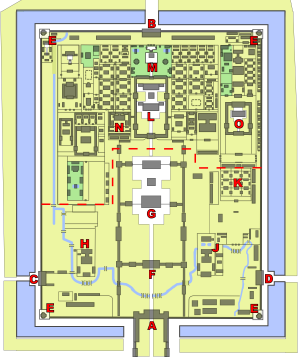
- - - Approximate dividing line between Inner (north) and Outer (south) Courts.
| A. Meridian Gate B. Gate of Divine Might C. West Glorious Gate D. East Glorious Gate E. Corner towers F. Gate of Supreme Harmony G. Hall of Supreme Harmony | H. Hall of Military Eminence J. Hall of Literary Glory K. Southern Three Places L. Palace of Heavenly Purity M. Imperial garden N. Hall of Mental Cultivation O. Palace of Tranquil Longevity |
The Forbidden City is the world's largest surviving palace complex and covers 72 hectares (178 acres). It is a rectangle 961 meters (3,153 feet) from north to south and 753 meters (2,471 feet) from east to west. It consists of 980 surviving buildings with over 8,728 rooms.[21] The Forbidden City was designed to be the center of the ancient, walled city of Beijing. It is enclosed in a larger, walled area called the Imperial City. The Imperial City is, in turn, enclosed by the Inner City; to its south lies the Outer City.
The Forbidden City remains important in the civic scheme of Beijing. The central north-south axis remains the central axis of Beijing. This axis extends to the south through Tiananmen gate to Tiananmen Square, the ceremonial center of the People's Republic of China. To the north, it extends through the Bell and Drum Towers to Yongdingmen. Interestingly, this axis is not exactly aligned north-south, but is tilted by slightly more than two degrees. Researchers now believe that the axis was designed in the Yuan Dynasty to be aligned with Xanadu, the other capital of the empire.[22]
Walls and Gates
The Forbidden City is surrounded by a 7.9-meter (26 foot) high city wall and a six-meter (19.7 foot), 52-meter (171 foot) wide moat. The walls are 8.62 meters (28.28 feet) wide at the base, tapering to 6.66 meters (21.65 feet) at the top.[23] These walls served as both defensive walls and retaining walls for the palace. They were constructed with a rammed earth core, and surfaced with three layers of specially baked bricks on both sides, with the interstices filled with mortar.[24]
At the four corners of the wall sit towers ("E") with intricate roofs boasting 72 ridges, reproducing the Pavilion of Prince Teng and the Yellow Crane Pavilion as they appeared in Song Dynasty paintings.[25] These towers are the most visible parts of the palace to commoners outside the walls, and much folklore is attached to them. According to one legend, artisans could not put a corner tower back together after it was dismantled for renovations in the early Qing Dynasty, and it was only rebuilt after the intervention of carpenter-immortal Lu Ban.
The wall is pierced by a gate on each side. At the southern end is the main Meridian Gate ("A").[26] To the north is the Gate of Divine Might ("B"), which faces Jingshan Park. The east and west gates are called the "East Glorious Gate" ("D") and "West Glorious Gate" ("C"). All gates in the Forbidden City are decorated with a nine-by-nine array of golden door nails, except for the East Glorious Gate, which has only eight rows.[27]
The Meridian Gate has two protruding wings forming three sides of a square (Wumen, or Meridian Gate, Square) before it.[24] The gate has five gateways. The central gateway is part of the Imperial Way, a stone flagged path that forms the central axis of the Forbidden City and the ancient city of Beijing itself, and leads all the way from the Gate of China in the south to Jingshan in the north. Only the Emperor may walk or ride on the Imperial Way, except for the Empress on the occasion of her wedding, and successful students after the Imperial Examination.[27]
Outer Court
Traditionally, the Forbidden City is divided into two parts. The Outer Court (外朝) or Front Court (前朝) includes the southern sections, and was used for ceremonial purposes. The Inner Court (内廷) or Back Palace (后宫) includes the northern sections, and was the residence of the Emperor and his family. It was used for day-to-day affairs of state. (The approximate dividing line shown as red dash in the plan above). Generally, the Forbidden City has three vertical axes. The most important buildings are situated on the central north-south axis.[27]
Entering from the Meridian Gate, one encounters a large square, pierced by the meandering Inner Golden Water River, which is crossed by five bridges. Beyond the square stands the Gate of Supreme Harmony ("F"). Behind that is the Hall of Supreme Harmony Square.[28] A three-tiered white marble terrace rises from this square. Three halls stand on top of this terrace, the focus of the palace complex. From the south, these are the Hall of Supreme Harmony (太和殿), the Hall of Central Harmony (中和殿), and the Hall of Preserving Harmony (保和殿).[29]
The Hall of Supreme Harmony ("G") is the largest, and rises some 30 meters (98.5 feet) above the level of the surrounding square. It is the ceremonial center of imperial power, and the largest surviving wooden structure in China. It is nine bays wide and five bays deep, the numbers nine and five being symbolically connected to the majesty of the Emperor. Set into the ceiling at the center of the hall is an intricate caisson decorated with a coiled dragon, from the mouth of which issues a chandelier-like set of metal balls, called the "Xuanyuan Mirror."[30] In the Ming Dynasty, the Emperor held court here to discuss affairs of state. During the Qing Dynasty, as Emperors held court far more frequently, the Hall of Supreme Harmony was only used for ceremonial purposes, such as coronations, investitures, and imperial weddings.[31]
The Hall of Central Harmony is a smaller, square hall, used by the Emperor to prepare and rest before and during ceremonies. Behind it, the Hall of Preserving Harmony was used for rehearsing ceremonies, and was also the site of the final stage of the Imperial examination.[32] All three halls feature imperial thrones, the largest and most elaborate one being that in the Hall of Supreme Harmony.[33]
At the center of the ramps leading up to the terraces from the northern and southern sides are ceremonial ramps, part of the Imperial Way, featuring elaborate and symbolic bas-relief carvings. The northern ramp, behind the Hall of Preserving Harmony, is carved from a single piece of stone 16.57 meters (54.3 feet) long, 3.07 meters (10 feet) wide, and 1.7 meters (5.6 feet) thick. It weighs some 200 metric tons and is the largest such carving in China.[4] The southern ramp, in front of the Hall of Supreme Harmony, is even longer, but is made from two stone slabs joined together—the joint was ingeniously hidden using overlapping bas-relief carvings, and was only discovered when weathering widened the gap in the twentieth century.[34]
In the south west and south east of the Outer Court are the halls of Military Eminence ("H") and Literary Glory ("J"). The former was used at various times by the Emperor to receive ministers and hold court, and later housed the Palace's own printing house. The latter was used for ceremonial lectures by highly regarded Confucian scholars, and later became the office of the Grand Secretariat. A copy of the Siku Quanshu was stored there. To the north-east are the Southern Three Places (南三所) ("K"), which was the residence of the Crown Prince.[28]
Inner Court
The Inner Court is separated from the Outer Court by an oblong courtyard lying orthogonal to the City's main axis. It was the home of the Emperor and his family. In the Qing Dynasty, the Emperor lived and worked almost exclusively in the Inner Court, with the Outer Court used only for ceremonial purposes.[35]The Inner Palace contained the residences of the emperor, his consorts and harem, and thousands of concubines, female servants and eunuchs. This area also housed storerooms, libraries and a hall of archives.
At the center of the Inner Court is another set of three halls ("L"). From the south, these are the Palace of Heavenly Purity (乾清宮), Hall of Union, and the Palace of Earthly Tranquility. Smaller than the Outer Court halls, the three halls of the Inner Court were the official residences of the Emperor and the Empress. The Emperor, representing Yang and the Heavens, would occupy the Palace of Heavenly Purity. The Empress, representing Yin and the Earth, would occupy the Palace of Earthly Tranquility. In between them was the Hall of Union, where the Yin and Yang mixed to produce harmony.[36]
The Palace of Heavenly Purity is a double-eaved building, set on a single-level white marble platform. It is connected to the Gate of Heavenly Purity to its south by a raised walkway. In the Ming Dynasty, it was the residence of the Emperor. However, beginning with the Yongzheng Emperor of the Qing Dynasty, the Emperor lived instead at the smaller Hall of Mental Cultivation to the west, out of respect for the memory of the Kangxi Emperor. The Palace of Heavenly Purity then became the Emperor's audience hall.[37] A caisson is set into the roof, featuring a coiled dragon. Above the throne hangs a tablet reading "Justice and Honor" (Chinese: 正大光明; pinyin: zhèngdàguāngmíng).[38]
The Palace of Earthly Tranquility (乾清宮) is a double-eaved building, nine bays wide and three bays deep. In the Ming Dynasty, it was the residence of the Empress. In the Qing Dynasty, large portions of the Palace were converted for Shamanist worship by the new Manchu rulers. Beginning with the reign of the Yongzheng Emperor, the Empress moved out of the Palace. However, two rooms in the Palace of Earthly Harmony were retained for use on the Emperor's wedding night.[39]
Between these two palaces is the Hall of Union, which is square in shape with a pyramidal roof. Stored here are the 25 Imperial Seals of the Qing Dynasty, as well as other ceremonial items.
Behind these three halls lies the Imperial Garden ("M"). Relatively small, and compact in design, the garden nevertheless contains several elaborate landscaping features.[40] To the north of the garden is the Gate of Divine Might, the north gate of the palace.
Distributed to the east and west of the three main halls are a series of self-contained courtyards and minor palaces, where the Emperor's concubines and children lived. Directly to the west is the Hall of Mental Cultivation ("N"). Originally a minor palace, this became the de facto residence and office of the Emperor starting with Yongzheng. In the last decades of the Qing Dynasty, Empresses Dowager, including Cixi, held court from the eastern partition of the hall. Located around the Hall of Mental Cultivation are the offices of the Grand Council and other key government bodies.[41]
The north-eastern section of the Inner Court is taken up by the Palace of Tranquil Longevity ("O"), a complex built by the Qianlong Emperor in anticipation of his retirement. It mirrors the set-up of the Forbidden City proper and features an "outer court," an "inner court," and gardens and temples. The entrance to the Palace of Tranquil Longevity is marked by a glazed-tile Nine Dragons Screen.[42]
Religion
Religion was an important part of life for the imperial court. In the Qing Dynasty, the Palace of Earthly Harmony became a place for Manchu Shamanist ceremonies. At the same time, the native Chinese Daoist religion continued to have an important role throughout the Ming and Qing dynasties. There were two Daoist shrines, one in the imperial garden and another in the central area of the Inner Court.[43]
A prevalent form of religion in the Qing Dynasty palace was Tibetan Buddhism, known as Lamaism. A number of temples and shrines were scattered throughout the Inner Court. Buddhist iconography also proliferated in the interior decorations of many buildings. Of these, the Pavilion of the Rain of Flowers is one of the most important. It housed a large number of Buddhist statues, icons, and mandalas, placed in ritualistic arrangements.[44]
Surroundings
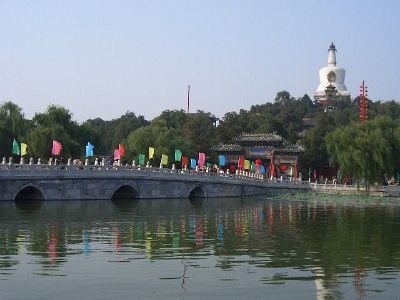
The Forbidden City is surrounded on three sides by imperial gardens. To the north is Jingshan Park, also known as Coal Hill, an artificial hill created from the soil excavated to build the moat and from nearby lakes.
To the west lies Zhongnanhai, a former garden centered on two connected lakes, which now serves as the central headquarters for the Communist Party of China and the State Council of the People's Republic of China. To the north-west lies Beihai Park, also centered on a lake connected to the southern two, and a popular park.
To the south of the Forbidden City were two important shrines—the Imperial Shrine of Family (Chinese: 太庙; pinyin: Tàimiào) and the Imperial Shrine of State (Chinese: 太社稷; pinyin: Tàishèjì), where the Emperor went to venerate the spirits of his ancestors and the spirit of the nation, respectively. Today, these are the Working People's Cultural Palace[45] and Zhongshan Park (commemorating Sun Yat-sen).[46]
To the south, two nearly identical gatehouses stand along the main axis. They are the Upright Gate (Chinese: 端门; pinyin: Duānmén)and the more famous Tiananmen Gate, which is decorated with a portrait of Mao Zedong in the center and two placards to the left and right: "Long Live the People's Republic of China" and "Long live the Great Unity of the World's Peoples." The Tiananmen Gate connects the Forbidden City precinct with the modern, symbolic center of the Chinese state, Tiananmen Square.
While development is now tightly controlled in the vicinity of the Forbidden City, throughout the past century uncontrolled and sometimes politically motivated demolition and reconstruction has changed the character of the areas surrounding the Forbidden City. Since 2000, the Beijing municipal government has worked to evict governmental and military institutions occupying some historical buildings, and has established a park around the remaining parts of the Imperial City wall.
Symbolism
The design of the Forbidden City, from its overall layout to the smallest detail, was meticulously planned to reflect philosophical and religious principles, and above all to symbolize the majesty of Imperial power. Some noted examples of symbolic designs include:
- Yellow is the color of the Emperor. Thus almost all roofs in the Forbidden City bear yellow glazed tiles. There are only two exceptions. The library at the Pavilion of Literary Profundity (文渊阁) had black tiles because black was associated with water, and thus fire-prevention. Similarly, the Crown Prince's residences have green tiles because green was associated with wood, and thus growth.
- The main halls of the Outer and Inner courts are all arranged in groups of three—the shape of the Qian triagram, representing Heaven. The residences of the Inner Court, on the other hand, are arranged in groups of six—the shape of the Kun triagram, representing the Earth.
- The sloping ridges of building roofs are decorated with a line of statuettes. The number of statuettes represents the status of the building—a minor building might have three or five. The Hall of Supreme Harmony has ten, the only building in the country to be permitted this in Imperial times. As a result, its tenth statuette (called a "Hangshi," or "ranked tenth" Chinese: 行什; pinyin: Hángshí),
- The layout of buildings follows ancient customs laid down in the Classic of Rites. Thus, ancestral temples are in front of the palace. Storage areas are placed in the front part of the palace complex, and residences in the back.
Collections
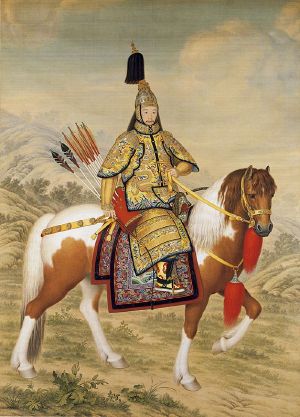
The collections of the Palace Museum are based on the Qing imperial collection. According to the results of a 1925 audit,[47] some 1.17 million items were stored in the Forbidden City. In addition, the imperial libraries housed one of the country's largest collections of ancient books and various documents, including government documents of the Ming and Qing dynasties.
From 1933, the threat of Japanese invasion forced the evacuation of the most important parts of the Museum's collection. After the end of World War II, this collection was returned to Nanjing. However, with the Communists' victory imminent in the Chinese Civil War, the Nationalist government decided to ship the pick of this collection to Taiwan. Of the 13,427 boxes of evacuated artifacts, 2,972 boxes are now housed in the National Palace Museum in Taipei. Almost ten thousand boxes were returned to Beijing, but 2,221 boxes remain today in storage under the charge of the Nanjing Museum.[48]
After 1949, the Museum conducted a new audit as well as a thorough search of the Forbidden City, uncovering a number of important items. In addition, the government moved items from other museums around the country to replenish the Palace Museum's collection. It also purchased and received donations from the public.
- Ceramic
The Palace Museum holds approximately 350,000 pieces of ceramics and porcelain. These include imperial collections from the Tang Dynasty and the Song Dynasty, as well as pieces commissioned by the Palace, and, sometimes, by the Emperor personally. The Palace Museum holds about 320,000 pieces of porcelain from the imperial collection.[49] The rest are almost all held in the National Palace Museum in Taipei and the Nanjing Museum.
- Paintings
The Palace Museum holds close to 50,000 paintings. Of these, more than 400 date from before the Yuan Dynasty (1271-1368). This is the largest such collection in China.[50] The collection is based on the palace collection in the Ming and Qing Dynasties. The personal interest of Emperors such as Qianlong meant that almost all surviving paintings from the Yuan Dynasty and before were held by the palace. However, a significant portion of this collection was lost over the years. After his abdication, Puyi transferred paintings out of the palace, and many of these were subsequently lost or destroyed. In 1948, the pick of the remaining collection were moved to Taiwan. The collection has subsequently been replenished, through donations, purchases, and transfers from other museums.
- Bronzeware
The Palace Museum's bronze collection dates from the early Shang Dynasty (founded c. 1766 B.C.E.). Of the almost 10,000 pieces held, about 1600 are inscribed items from the pre-Qin period (to 221 B.C.E.). A significant part of the collection is ceremonial bronzeware from the imperial court.[51]
- Timepieces
The Palace Museum has one of the largest collections of mechanical timepieces of the eighteenth and nineteenth centuries in the world, with more than one thousand pieces. The collection contains both Chinese- and foreign-made pieces. Chinese pieces came from the palace's own workshops, Guangzhou (Canton) and Suzhou (Suchow). Foreign pieces came from countries including Britain, France, Switzerland, the United States, and Japan. Of these, the largest portion come from Britain.[52]
- Jade
Jade has a unique place in Chinese culture.[53] The Museum's collection, mostly derived from the imperial collection, includes some 30,000 pieces. The pre-Yuan Dynasty part of the collection includes several pieces famed throughout history, as well as artifacts from more recent archaeological discoveries. The earliest pieces date from the Neolithic period. Ming Dynasty and Qing Dynasty pieces, on the other hand, include both items for palace use, as well as tribute items from around the Empire and beyond.[54]
- Palace artifacts
In addition to works of art, a large proportion of the Museum's collection consists of the paraphernalia of the imperial court. This includes items used by the imperial family and the palace in daily life, as well as various ceremonial and bureaucratic items important to government administration. This comprehensive collection preserves the daily life and ceremonial protocols of the imperial era.[55]
Influence
- Architecture
The Forbidden City, the culmination of the two-thousand-year development of classical Chinese and East Asian architecture, has been influential in the subsequent development of Chinese architecture, as well as providing inspiration for many modern constructions. Some specific examples of its influences include:
- Emperor Gia Long of Vietnam built a palace and fortress that was intended to be a smaller copy of the Chinese Forbidden City in the 1800s. Its ruins are in Hue. In English it is called the "Imperial City." The name of the inner palace complex in Vietnamese is translated literally as "Purple Forbidden City," which is the same as the Chinese name for the Forbidden City in Beijing.
- The 5th Avenue Theatre in Seattle, Washington was designed to incorporate elements of classical Chinese architecture and interior decoration. The ceiling of the auditorium features a dragon panel and chandelier reminiscent of the dragon caisson and Xuanyuan mirror found in the Forbidden City.[56]
- Depiction in art, film and literature
The Forbidden City has served as the setting of many works of fiction. In recent years, it has been depicted in films and television series. Some notable examples include:
- The Last Emperor (1987), a biographical film about Puyi, was the first feature film ever authorized by the government of the People's Republic of China to be filmed in the Forbidden City.
- Marco Polo a joint NBC and RAI TV miniseries broadcast in the early 1980s, was filmed inside the Forbidden City. Note, however, that the present Forbidden City did not exist in the Yuan Dynasty, when Marco Polo met Kublai Khan.
- As performance venue
The Forbidden City has also served as a performance venue. However, its use for this purpose is strictly limited, due to the heavy impact of equipment and performance on the ancient structures. Almost all performances said to be "in the Forbidden City" are held outside the palace walls.
- Giacomo Puccini's opera, Turandot, about the story of a Chinese princess, was performed at the Imperial Shrine just outside the Forbidden City for the first time in 1998.[57]
- In 2004, the French musician Jean Michel Jarre performed a live concert in front of the Forbidden City, accompanied by 260 musicians, as part of the "Year of France in China" festivities.[58]
Notes
- ↑ Guo-hui Gan, "Perspective of urban land use in Beijing." GeoJournal 20 (4) (April, 1990): 359-364.
- ↑ 2.0 2.1 Zhuoyun Yu, Palaces of the Forbidden City (New York: Viking, 1984, ISBN 0670537217), 18.
- ↑ "Gugong" in a generic sense also refers to all former palaces, another prominent example being the former Imperial Palaces (Mukden Palace) in Shenyang.
- ↑ 4.0 4.1 4.2 Xiagui Yang, Shaobai Li, (photography); Huang Chen, (translation), The Invisible Palace (Beijing: Foreign Language Press, 2003, ISBN 7119034324), 15.
- ↑ China Central Television, The Palace Museum Gugong: "I. Building the Forbidden City" (Documentary) (China: CCTV, 2005).
- ↑ Yu, 21.
- ↑ Yang, 69.
- ↑ Wu Han (PRC) 朝鲜李朝实录中的中国史料 (Chinese historical material in the Annals of the Joseon Yi Dynasty) (Beijing: Zhonghua Book Company, 1980. CN / D829.312), 3734.
- ↑ Guo Moruo, 甲申三百年祭 (Commemorating 300th anniversary of the Jia-Sheng Year) New China Daily, March 20, 1944 (Chinese).
- ↑ China Central Television, The Palace Museum Gugong: "II. Ridgeline of a Prosperous Age" (Documentary) (China: CCTV, 2005).
- ↑ 11.0 11.1 China Central Television, The Palace Museum Gugong: "XI. Flight of the National Treasures" (Documentary) (China: CCTV, 2005).
- ↑ Yang, 137.
- ↑ Puyi Aisin-Gioro, From Emperor to Citizen: The autobiography of Aisin-Gioro Pu Yi (Oxford University Press, 1988, ISBN 0192820990).
- ↑ Restoration of Jianfu Palace Garden Narrative Made. Retrieved February 9, 2023.
- ↑ History of NPM National Palace Museum. Retrieved February 9, 2023.
- ↑ Joel Martinsen, Tear Down the Palace! China Heritage Quarterly, No. 24, December 2010. Retrieved February 9, 2023.
- ↑ Jie Chen, Several horrifying reconstruction proposals had been made for the Forbidden City. Yangcheng Evening News, February 4, 2006.
- ↑ 18.0 18.1 History of the Forbidden City - 1406 to the Present) China Highlights, July 30, 2021. Retrieved February 9, 2023.
- ↑ Imperial Palaces of the Ming and Qing Dynasties in Beijing and Shenyang UNESCO. Retrieved February 8, 2023.
- ↑ Francesca Street, Beijing's Forbidden City will open newly restored buildings in 2020 CNN, February 4, 2019. Retrieved February 9, 2023.
- ↑ 15 Interesting Forbidden City Facts You Didn't Know China Highlights, December 29, 2021. Retrieved February 9, 2023.
- ↑ Liu Fang, Xanadu and Chengjiang Fossil Site placed on elite list China Culture. Retrieved February 9, 2023.
- ↑ Yang, 25.
- ↑ 24.0 24.1 Yu, 32.
- ↑ Yu, 33.
- ↑ Technically, Tiananmen Gate is not part of the Forbidden City; it is a gate of the Imperial City.
- ↑ 27.0 27.1 27.2 Yu, 25.
- ↑ 28.0 28.1 Yu, 49.
- ↑ Yu, 48.
- ↑ Yu, 253.
- ↑ Kelly Pang, Hall of Supreme Harmony(Taihe Hall) China Highlights, July 28, 2021. Retrieved February 9, 2023.
- ↑ Hall of Preserving Harmony (Baohe dian) The Palace Museum. Retrieved February 9, 2023.
- ↑ Yu, 70.
- ↑ Yu, 213.
- ↑ Yu, 73.
- ↑ Yu, 75.
- ↑ Yu, 78.
- ↑ Yang, 51.
- ↑ Yu, 80-83.
- ↑ Yu, 121.
- ↑ Yu, 87.
- ↑ Yu, 115.
- ↑ Yu, 176.
- ↑ Yu, 189-193.
- ↑ Working People's Cultural Palace. China Internet Information Center. Retrieved February 9, 2023.
- ↑ Zhongshan Park China Internet Information Center. Retrieved February 9, 2023.
- ↑ Lianxi Wen (ed.), 故宫物品点查报告 [Forbidden City Items Check Report] Caretaker Committee of the Qing Dynasty Imperial Family (Beijing: Xianzhuang Book Company, 2004 (original 1925), ISBN 7801062388).
- ↑ 三大院长南京说文物 (Three museum directors talk artefacts in Nanjing) Jiangnan Times, October 19, 2003. Retrieved February 9, 2023.
- ↑ Collections: Ceramics The Palace Museum. Retrieved February 9, 2023.
- ↑ Collections: Paintings The Palace Museum. Retrieved February 9, 2023.
- ↑ Collections: Bronzes The Palace Museum. Retrieved February 9, 2023.
- ↑ Collections: Timepieces and Instruments The Palace Museum. Retrieved February 9, 2023.
- ↑ Berthold Laufer, Jade: A Study in Chinese Archeology & Religion (Gloucester, MA: Peter Smith Pub Inc., 1989, ISBN 978-0844652146).
- ↑ Collections: Jade and Precious Stones The Palace Museum. Retrieved February 9, 2023.
- ↑ Collections: Palace Paraphernalia The Palace Museum. Retrieved February 9, 2023.
- ↑ The Story of the 5th The 5th Avenue Theater. Retrieved February 9, 2023.
- ↑ Chris Devonshire-Ellis. China Remembered: Turandot at the Forbidden City China Briefing, August 21, 2009. Retrieved February 9, 2023.
- ↑ Jean Michel Jarre lights up China BBC News, October 11, 2004. Retrieved February 9, 2023.
ReferencesISBN links support NWE through referral fees
- Aisin-Gioro, Puyi. From Emperor to Citizen: The autobiography of Aisin-Gioro Pu Yi. Oxford University Press, 1988 (original 1964). ISBN 0192820990
- Ho, Chuimei, and Bennet Bronson. Splendors of China's Forbidden City. London: Merrell Publishers, 2004. ISBN 1858942586
- Huang, Ray. 1587, A Year of No Significance: The Ming Dynasty in Decline. New Haven: Yale University Press, 1981. ISBN 0300025181
- Laufer, Berthold. Jade: A Study in Chinese Archeology and Religion. Gloucester, MA: Peter Smith Pub Inc., 1989 (original 1912). ISBN 978-0844652146
- Yang, Xiagui, and Shaobai Li, (photography); Huang Chen (translation). The Invisible Palace. Beijing: Foreign Language Press, 2003. ISBN 7119034324
- Yu, Zhuoyun. Palaces of the Forbidden City. New York: Viking, 1984. ISBN 0670537217
- Wen, Lianxi (ed.). 故宫物品点查报告 [Forbidden City Items Check Report] Caretaker Committee of the Qing Dynasty Imperial Family. Beijing: Xianzhuang Book Company, 2004 (original 1925). ISBN 7801062388
External links
All links retrieved February 5, 2023.
- Palace Museum official site
- National Palace Museum official site (Taiwan)
- Satellite photograph of the Forbidden City
- Forbidden City: Highlights, Secret of the Name, Facts China Highlights
- Forbidden City, China (Palace Museum) Travel China Guide
| |||||||
| ||||||||||||||
Credits
New World Encyclopedia writers and editors rewrote and completed the Wikipedia article in accordance with New World Encyclopedia standards. This article abides by terms of the Creative Commons CC-by-sa 3.0 License (CC-by-sa), which may be used and disseminated with proper attribution. Credit is due under the terms of this license that can reference both the New World Encyclopedia contributors and the selfless volunteer contributors of the Wikimedia Foundation. To cite this article click here for a list of acceptable citing formats.The history of earlier contributions by wikipedians is accessible to researchers here:
The history of this article since it was imported to New World Encyclopedia:
Note: Some restrictions may apply to use of individual images which are separately licensed.
